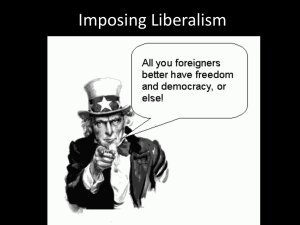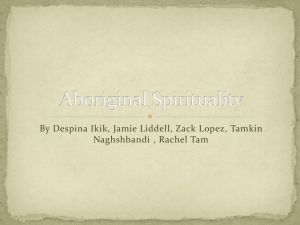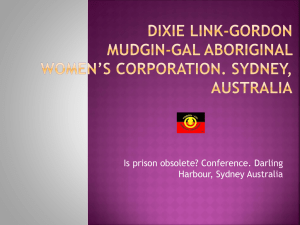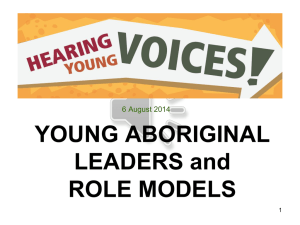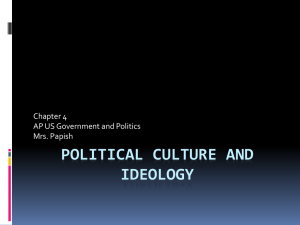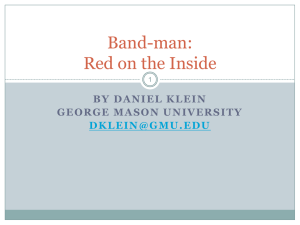Related Issue #3 - Chapter #9
advertisement
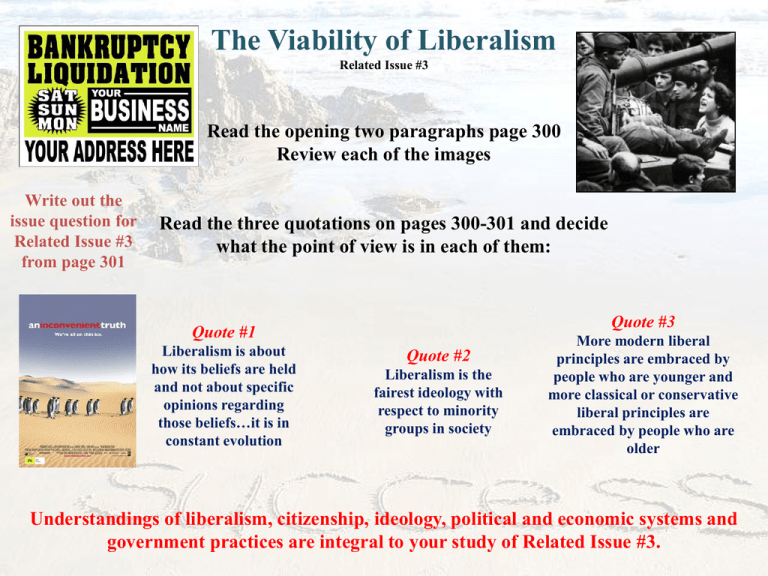
The Viability of Liberalism Related Issue #3 Read the opening two paragraphs page 300 Review each of the images Write out the issue question for Related Issue #3 from page 301 Read the three quotations on pages 300-301 and decide what the point of view is in each of them: Quote #3 Quote #1 Liberalism is about how its beliefs are held and not about specific opinions regarding those beliefs…it is in constant evolution Quote #2 Liberalism is the fairest ideology with respect to minority groups in society More modern liberal principles are embraced by people who are younger and more classical or conservative liberal principles are embraced by people who are older Understandings of liberalism, citizenship, ideology, political and economic systems and government practices are integral to your study of Related Issue #3. Imposing Liberalism Chapter Nine Read Pages 302– 303 How is it possible that Canada consistently ranks within the top ten best countries in the world in which to live, according to the United Nations'’ human development scale, when many Aboriginal communities in Canada are living in conditions similar to those of a developing country? Write out the issue question for Chapter Nine from page 303 Aboriginal Experiences of Liberalism in Canada The opening section of chapter nine will be focusing on… The effects of the imposition of liberalism on First Nations, Métis and Inuit peoples by North American colonial governments- and later by the Canadian government The differences between Aboriginal and European ideologies How the above differences led to conflicts over issues such as governance and land holding Efforts taken to assimilate Aboriginal peoples into non-Aboriginal Canadian society Important Terms to Know In Canada, Aboriginal peoples includes First Nations, Metis and Inuit peoples Use this term when a specific group is not named Indigenous peoples is the most appropriate general term to use when discussing first peoples The term Indian is considered offensive to many in Canada, but is actually preferred by others outside of Canada Click here for more information Great Law of Peace Refer to page 116 to remind yourself how this historical Iroquois document is related to classical liberalism The Great Law of Peace provided the Haudenosaunee (Iroquois) peoples with a constitution that dates back to the 15th century. The Great Binding Law, as it sometimes is referred to, has three main principles: righteousness, health and power – all characteristics of liberalism. Take a look at the original document. Aboriginal Contributions to Liberalism It has been argued that many of the principles of liberalism originated in traditional Aboriginal societies. In Canada, our Aboriginal communities use liberal ideas such as elected leaders, government by consensus, leadership on the basis of merit, just punishment, and concepts of equality and equality before the law. Conflicting Ideologies 1. Read the introduction on page 304 and “Conflicting Ideologies” (Pages 305 -306) and explain the difference in ideologies between the Europeans and Aboriginal peoples. 2. Read “Conflicting Land-Holding Ideologies (Pgs. 307-308 ) • How are the conceptions of land described in the quotes on page 307 different from liberal ideologies of property and ownership? • Given the differences between these views and principles of liberalism, what potential conflicts might arise over land use? • What do you think was the root cause of this attitude that the Europeans brought to treaty negotiations? • How does this difference in understandings of historical agreements between First Nations and the Canadian government help explain the large number of land claims currently being negotiated between various First Nations and the Canadian government? Brainstorming Name some situations where Aboriginal peoples and Canadian governments have come into conflict . Why do you think the relationship between Canada’s Nations peoples and Aboriginal Experiences in First Canada governments has occasionally been marked by troubles and conflicts? A Closer LookFirst Nations peoples? What are the main concerns of Canada’s How have the First Nations sought to present these concerns to governments and society as a whole? How successful have First Nations been in having their issues addressed, and gaining a resolution to their main concerns? The Oka Crisis Browse the Oka topic for 15 to 20 minutes (CBC archives) watching and listening to the video and audio clips in any order you wish. As you explore, make notes about the following: What were the main causes of the Oka crisis? Who were the major individuals involved in it? What were the main events of the crisis during the summer of 1990? How was the crisis eventually ended? What was the impact of the crisis on relations between First Nations peoples and governments in Canada? Why did the Oka crisis receive so much attention in Canada during the summer of 1990? Aboriginal Experiences of Liberalism in Canada Assignment Using the CBC Radio and Television Archives Web site along with other relevant sources of information: Prepare a summary or overview of one of the following issues involving First Nations peoples and governments in Canada: • • • • • Standoff at Ipperwash Provincial Park, Ontario Dispute over Mic’maq lobster fishing rights at Burnt Church, N.B. Nisga’a land claims treaty and controversy over it in British Columbia. Land claims negotiations between Quebec government and James Bay Cree The Royal Commission on Aboriginal Peoples and its impact You may also choose another important issue involving an attempt by the Canadian government to impose liberalism on Aboriginal peoples in Canada. Aboriginal Experiences of Liberalism in Canada Assignment What to include: • Brief introduction /explanation of event/issue • Explanation of why the issue/event is important to First Nations • Explanation of why the issue/ event is an example of the imposition of liberalism on Aboriginal peoples. • Explanation of actions taken to resist the policies or practices imposed by the Canadian (or other government) • Explanation of whether or not the attempt to resist the imposition of liberalism was successful • Closure: Leave your audience with a question or thought to ponder Aboriginal Experiences of Liberalism in Canada After reading up to page 310, take the following notes on: Early Conflict Conflicting Ideologies In the 19th century, the ideology of classical liberalism, and the concept of progress associated with it, became a dominant force in the thinking of many European and North American colonial leaders. This ‘faith in progress’ had become an ideology: “…it consists of irreversible changes in one direction only, and that this direction is towards improvement” This ideology contrasted sharply with beliefs that are considered common in most aboriginal cultures, known as: “The Laws of Sacred Life” “Laws of Nature” and “Laws of Mutual Support” The principles included in these laws (as found on page 306) lead to misunderstandings in areas such as land ownership, education, work and governance Land Holding Conflicts Viewed land ownership differently Europeans believed that they personally could own the land First Nations believed that land was borrowed from the Creator – not something that was owned As more immigrants arrived, more land was needed Treaties were signed In exchange for the land, First Nations were given annual payments, social and economic benefits, and continued use of some land and resources The Problem with Treaties… First Nations used oral agreements and traditions, Europeans had a history of written documents Language was a barrier – interpreters didn’t grasp both languages, some words (exclusive land ownership) had no equivalent in First Nations languages Europeans called the legal status of these agreements into question, even though they were written Came to believe that First Nations were not sovereign nations and stopped treating the treaties as valid international agreements Assimilation via…Enfranchisement Gradual Civilization Act (1857) Any First Nations male who gave up his official Indian status would be considered enfranchised and given 50 acres of land for his personal use He would continue to receive his share of treaty settlements and band money When he died, ownership of land would be given to his children and removed from the band’s reserve Assimilation via…Indian Act (1876) Defined what First Nations could and could not do Defined who was considered to be a First Nations person Encouraged Aboriginals to abandon their Indian status and identity to become members of Canadian society Regarded First Nations’ children as wards of the state Tried to suppress cultures by banning traditional practices (see page 315 for an example) Until 1960, voting was only allowed for those who moved off of the reserve (and was therefore not considered to be a status Indian) and gave up their treaty rights Assimilation via…Residential Schools Mandatory boarding schools for Aboriginal children that had the primary goal of assimilating them into Western cultures and traditions According to the Indian Act, the federal government was responsible for the education of First Nations children School age children were taken from their families and placed in these schools where they lived, worked, and studied Returned home for the summer and required to return in August More Info: http://archives.cbc.ca/society/native_issues/topics/692/ Residential Propaganda: CBC - 1955 (3:00) The White Paper Aboriginal people in Canada took hope with the election of Pierre Trudeau's Liberals in 1968. They were outraged when the White Paper introduced by Minister of Indian and Northern Affairs Jean Chretien a year later amounted to an assimilation program: the repeal of the Indian Act, the transfer of Indian affairs to the provinces, the elimination of separate legal status native people. The Unjust Society, Cree leader Harold Cardinal's stinging rebuttal, was an immediate best-seller, and it remains one of the most important books ever published. Read pages 310 – top 312 in preparation for taking the following notes Cardinal summed up the government's approach as "The only good Indian is a non-Indian." He coined the term "buckskin curtain" to describe the barriers that indifference, ignorance and bigotry had placed in the way of his people. He insisted on his right to remain "a red tile in the Canadian mosaic." Above all, he called for radical changes in policy on aboriginal rights, education, social programs and economic development. The Unjust Society heralded a profound change in the political landscape. Thirty years later, however, the buckskin curtain has still not disappeared. Canada's First Nations continue their fight for justice. And Harold Cardinal's vision is as compelling and powerful as ever. Taking a Stand against Assimilation: The Red Paper National Indian Brotherhood published: “Citizen Plus” Aboriginals responded with their own document, named Citizens Plus, in 1970 This became more commonly known as the Red Paper The Red Paper countered all of the proposals of the White Paper An Aboriginal delegation, backed by other Canadian citizens, met with the government and successfully convinced it to radically change its policies and positions See page 311 of your text. Constitutional Act - 1982 The constitutional document was signed by the Queen in Canada on April 17, 1982 It included two additional sections dealing with the aboriginal peoples Section 25 which provides guarantees and protection of aboriginal and treaty rights in relation to the Charter of Rights Section 37 which dealt with a future constitutional conference which would include Aboriginal Representatives A series of constitutional conferences on Aboriginal rights were held between 1983 and 1987 Contemporary Solutions: Land Claims and the Constitution Read the rest of page 312 – 314 and take your own summary notes on these two sections The Royal Commission on Aboriginal Peoples and the Healing Fund When finished… Explore the Issues: Complete 1(a) & 1(b) on page 316 Bringing Liberalism to the World Read over the quote on page 318 From a multiculturalist perspective, no political doctrine or ideology can represent the full truth of human life. Each of them – be it liberalism, conservatism, socialism or nationalism – is embedded in a particular culture, represents a particular vision of the good life, and is necessarily narrow and partial. Liberalism, for example, is an inspiring political doctrine stressing such great values as human dignity, autonomy, liberty, critical thought and equality. However, they can be defined in several different ways, of which the liberal is only one and not always the most coherent. And [liberalism]also ignores or marginalizes such other great values as human solidarity, community, a sense of rootedness, selflessness, deep and self-effacing humility and contentment. Since it grasps only some aspects of the immensely complex human existence and misses out too much of what gives value to life, liberalism, socialism or for that matter any other political doctrine cannot provide the sole basis of the good society. Political doctrines are ways of structuring political life and do not offer a comprehensive philosophy of life. And even so far as political life is concerned, they need to be interpreted and defined in the light of the wider culture and the unique history and political circumstances of the community concerned. To what extent is the position expressed in the quotation consistent with the principles of liberalism? Does the quotation provided an argument based on individualism, on concern for collectivism, or on aspects of both of these ideas? Who, if anyone, has the right to impose his or her ideology on another? Bringing Liberalism to the World While reading pages 318 - 325 complete questions 1-5 in the handout: Bringing Liberalism to the World Zimbabwe Political turmoil and poor management of the economy have led to considerable economic hardships. Zimbabwe As you watch this report, decide if Mugabe’s reaction (pg. 324) is warranted. Zimbabwe – A Failed State (25:00) Continue reading up to page 329 and complete the rest of the handout: Bringing Liberalism to the World When finished… Explore the Issues: Complete #1 on page 330 assimilation The drive to assimilate First Nations into the mainstream of Canadian life by changing their customs, dress, occupations, language, religion and philosophy. This has always been an element in Federal-First Nations relations. humanitarianism Trying to improve the lives of others and to reduce their sufferings through various means, including social reform and aid. Indian act An act of Parliament first passed in 1867, since amended many times, dealing with the governance of reserves, and the rights and benefits of registered individuals. Included under the act are First Nations peoples (and other descendants) who signed treaties or were otherwise registered in the act.



